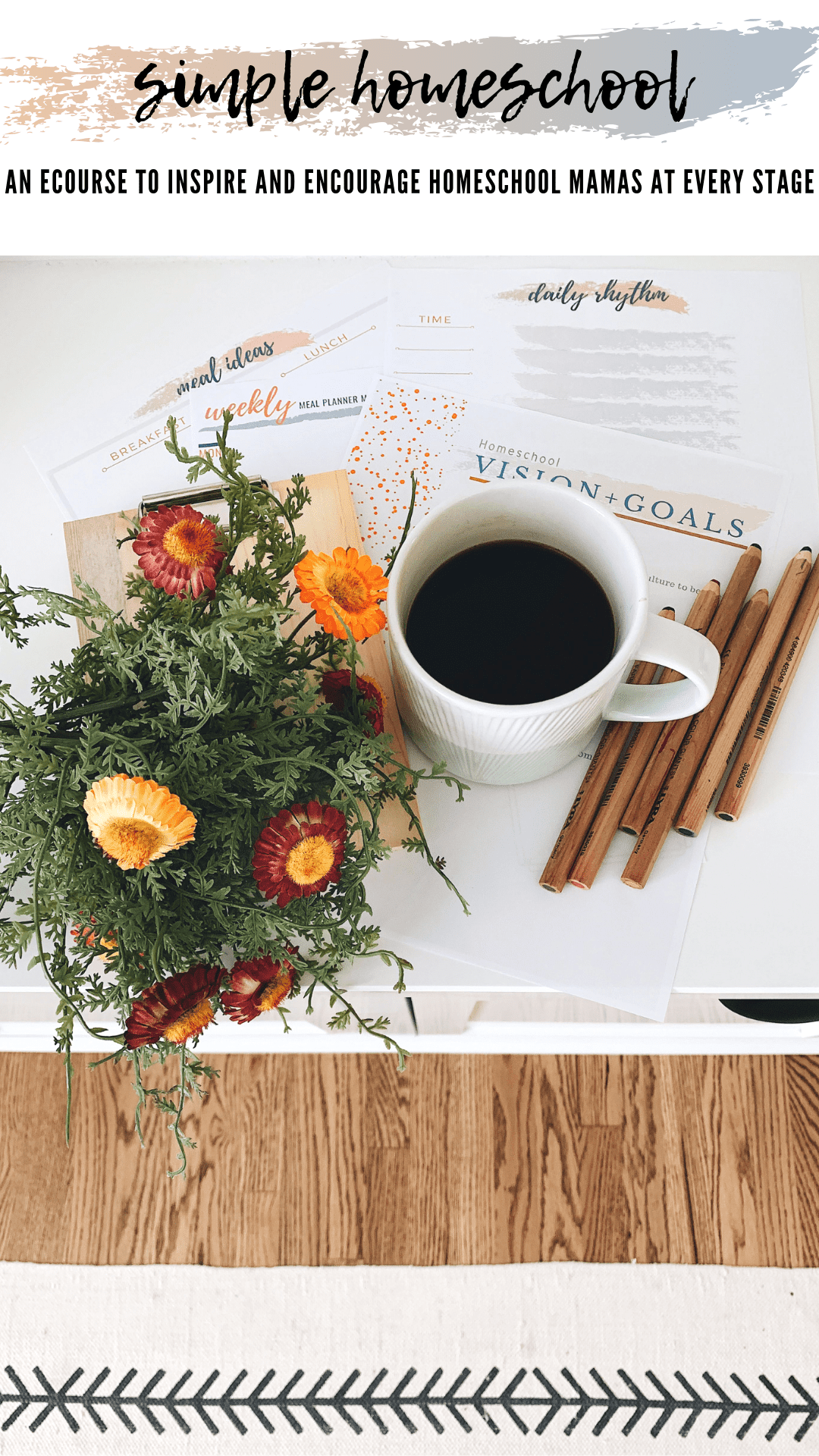An Easy Guide for Homeschool Planning
While homeschooling isn’t for every family, it is a wonderful journey for those of us who have chosen to educate our children at home. Today, I’m going to share an easy, step-by-step guide for homeschool planning to help make your next year a success!

After homeschooling for over nine years, there are a few things I’ve learned. One of them is the importance of planning. Planning for homeschool isn’t hard, but it does take some time if you aren’t sure which direction you want to go in.
Knowing what works, or what doesn’t work, for your homeschool is half of the battle. If you are needing some help with homeschool planning, keep reading this post. This will give you a framework for planning your next year the simple way!
Planning for Homeschool: The Best Time to Plan
Everyone will plan their homeschool year differently, but the best time to plan for your next year is THIS year. February or March is a great time to begin thinking about the next year and jotting things down.
Why should homeschool planning start in February?
- Homeschool planning should start in February because, as a teacher, your mind is still fresh and you have a good visual as to what is working and what is not. If you wait until summertime, it’s easy to forget little things that you wanted to change about your past school year.
- This method of planning gives you time to research the curriculum and even ask fellow homeschoolers their thoughts on what you are considering for your homeschool classroom.
- Planning for homeschool in February also ensures that your new curriculum will be in your hands in time for you to plan for the upcoming year. Sometimes, things get back ordered and aren’t available for months after ordering, so ordering in advance keeps you from panicking when it’s July and you still don’t have your books.
- Ordering curriculum several months before the new school year allows you the opportunity to handle and flip through the new books. If you, for some reason, don’t like what you ordered, you have time to send it back and order something to replace it.

Planning for Homeschool: Choosing Homeschool Curriculum
Choosing homeschool curriculum can seem daunting, but once you get some systems in place, it’s not too hard.
Start with Curriculums you know you love
The easy place to start is with those curriculums that you are certain you will be using. Start a checklist for each student with each subject listed below his/her name. Jot down the curriculums you know you will be using the next school year to see what is left to research.
For example, maybe you are a Saxon math family. You have used that curriculum and want to continue with it for next year. Write that down for each student in their “math” slot on their checklist. Maybe you are a tried and true Abeka Language fan. Write that down in their “grammar/language” slot on their checklist. Those are now out of the way and you can move on.
Next, research the subjects you aren’t sure about
Once you have your list with you subjects that you are sure about filled in, it makes it easier to see what is left to research. This next step is where you need to consider what style of homeschool you want to have.
There are many different styles of homeschooling, so it’s helpful to look at them and decide what you want your school culture to look like. Homeschooling starts with knowing what you want your family culture to be like. Everything else after that falls into place.
Let’s take a look at the different methods of homeschooling. Remember, you can mix the styles you have in your homeschool philosophy. What is important is that you choose a style (or styles) that you will actually implement into your school and be successful in.

Homeschooling Styles
Charlotte Mason
The Charlotte Mason method is a literature-rich education method that focuses on quality literature and short, rigorous lessons. This method focuses on learning through literature and having the student “narrate” the information he recalls to the teacher. There are read alouds that the teacher initiates, along with time for the student to read independently.
Classical Education
The Classical Education method focuses on moving through each subject- reading, writing, arithmetic, as well as logic, while focusing on analytical thinking. Typically, this is explained as a “literature focused” method that encourages students to ask and answer questions about what they are learning, namely “why.”
Montessori Education
The Montessori education method is typically used for the younger years of education. A teacher is to prepare the learning environment with many stimuli for the child to explore and engage with. This is a very hands-on learning approach that gives the child plenty of time to observe things around them.
Unschooling
The Unschooling method focuses on allowing the student to learn the subject material that most interests the student. It is, somewhat, a student led method. If the student is interested in horses, then learning material will be connected to horses.
This method also encourages learning outside of the classroom. Nature walks and nature journaling is a common part of the unschooling curriculum.
Unit Studies
Unit studies schooling is a method where the curriculum is focused on units and that unit spans/connects across each subject area. For example, if you have a child interested in the ocean, you will have your child:
- Reading a literature book on the ocean
- Learning about ocean habitats in science
- Research a history ocean explorer in history
- Memorize a spelling list with ocean-themed words on it
For the unit studies method, everything connects together to create a well-rounded unit spanning each subject area.

Planning for Homeschool: Buying Curriculum
Buying homeschool curriculum is a part of planning for homeschooling. There are several places to find curriculum, including ebay and on Facebook marketplace, but my favorite places to source curriculum are below.
Places to Source Homeschool Curriculum
- Christian Book– This is a great place to find a variety of curriculum choices all in one place. Christian Book runs sales and also ships in a timely manner. If things are backordered, they send out email notifications.
- Rainbow Resources– Rainbow Resources has great prices on a variety of curricula.
- Directly from the Publisher– usually more expensive and you can’t get any other curriculums from this source, which means you could pay more in shipping from having to order from multiple sites.
Planning for Homeschool: Create a Schedule
As a homeschool teacher, you get to decide what your schedule will look like. Every homeschool mom does things a little bit differently. This is where you need to decide how you want your mornings/days to flow and what is realistic for your current lifestyle.
Things to consider:
- Will you be educating different ages?
- Do you have a busy lifestyle filled with lots of “to-dos”?
- Are there babies and toddlers that might interrupt learning time?
- What are the personalities of you and your children and which method do you think will best compliment them?
There are different types of homeschool schedules and those questions above are important when determining which one to use. Remember, if you start with one schedule and you find it isn’t working, you have the freedom to switch it up. Don’t force something that simply isn’t working.
Types of Homeschool Schedules
- Block Schedule– This is a schedule where you create time blocks within your day and move from one subject to another according to the time blocks. This works much like a traditional school does. Once the time is done, you move on to the next subject. This schedule is more methodical and doesn’t allow for much flexibility, but it also keeps the student moving along throughout the day.
- Checklist Schedule- This schedule is one where you create a checklist for each subject or task and once the student is finished with the task, he checks it off and moves on to the next task. It doesn’t matter what order the list is finished in, as long as it gets completed each day.
- Routine Schedule– This schedule has an “order of events,” but it doesn’t have the events timed. For example, a child might have a routine in this order: Reading, Literature, Math, Science, History, Writing. The child moves through his lessons in that order each day, but there isn’t a specific allotted time for him to complete it in. Whenever he is finished with reading, he checks it off his list and he moves on to literature, and so on.

Streamline your Homeschool Planning
Planning for homeschooling can feel like a daunting task, but once you get in your groove, it isn’t that hard. You will find certain curriculums that work great and you will stick with those. You will also find ones that do not work and you can throw them out and not look back.
Streamline your homeschool planning by keeping a good list of what each child does for his school each year. This helps when planning for younger kiddos because you can consult with our past lists that you used for older kids.
This will also allow you to lesson plan for each curriculum and reuse those lesson plans for younger students. This is a “plan once, teach multiple times” kind of method. It isn’t a perfect method, but it works really well for homeschoolers who have multiple kids to teach. So, be sure to keep a record of what you use and save your lesson plans for future years.
Homeschooling starts with knowing what you want your family culture to be like. Everything else after that falls into place.
Liz Quick
More Homeschool Planning Posts
This post is part of a Homeschool Planning series that will be happening over the course of the next month. This is the first post in this series and the rest will be linked below as they are published. For now, you can enjoy my New Year’s vision post below.
- Homeschool Mom’s New Year’s Vision
- POST 2 in this Series: Homeschool Lesson Planning with FREE Templates

Simple Homeschool Planning eCourse
If you’re looking for more in depth information and support, but sure to look at my Simple Homeschool eCourse. It is a video-based course that you can work through at your own pace that will give you encouragement and direction as you plan your new school year.
In this course, I share videos on our homeschool culture, how I plan and schedule our days, how things have shifted from when we had little ones til now, and so much more.
Pin for later








So helpful, I really enjoyed reading this the way you have it written out. Will definitely be coming back to refer to this info this year as I plan for my daughters first year of homeschool
I’m so glad it was a benefit to you. Happy planning!
This is SUCH an informational post! I tend to not plan ahead as much as I should and there’s so much here that will help me be prepared and stay organized.
Yay! I am glad you found it helpful.